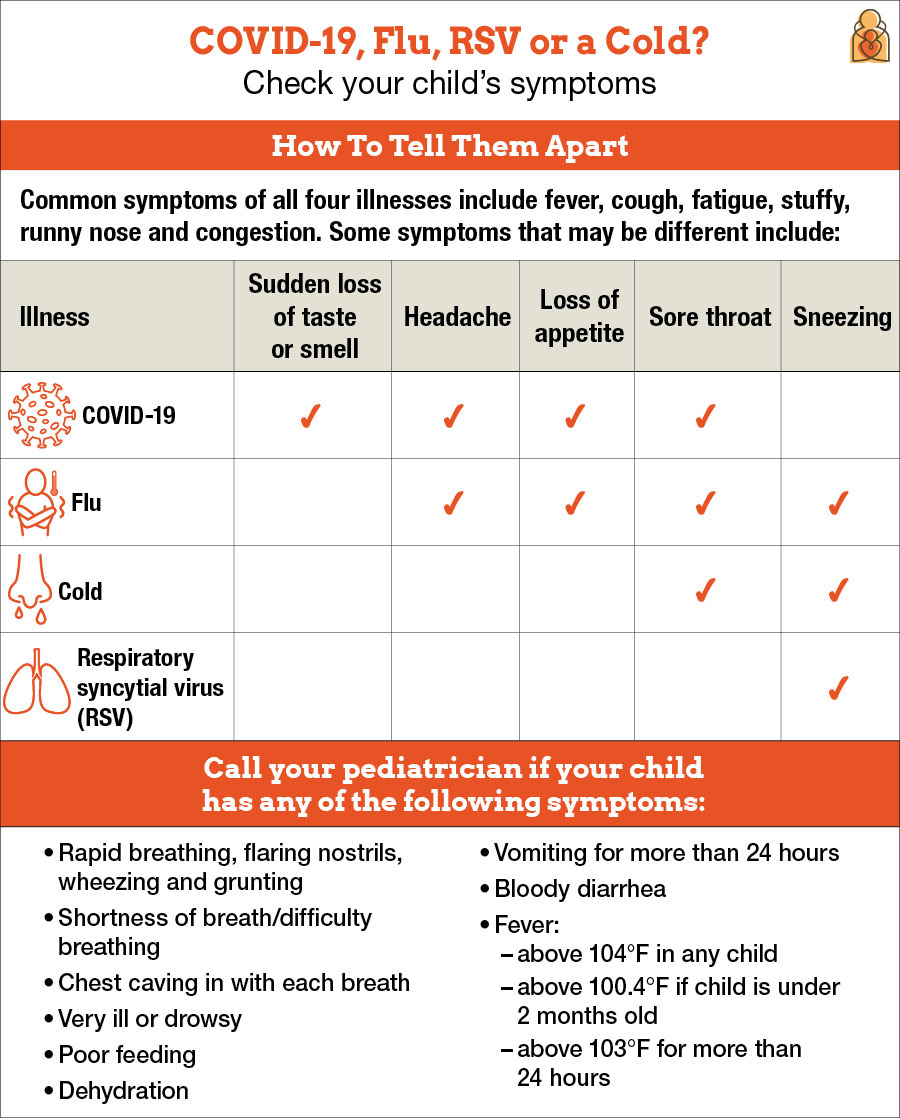COVID-19 & Other Respiratory Illnesses: How Are They Different?
Your child has a stuffy nose, cough and fever. Is it a cold? The flu? Or are they symptoms of COVID? Some COVID, flu, respiratory syncytial virus (RSV) and cold symptoms can be alike. But there are some clues that set each of these common viruses apart.
Even with masks and vaccines, contagious viruses are still spreading that lead to sniffles, sneezing and coughing.
Is it COVID-19, the flu, RSV or a common cold?
Let’s look at the viruses that cause four common childhood illnesses—COVID-19, flu, the common cold and respiratory syncytial virus (RSV).
All of them share some similar symptoms. This can make it hard to tell them apart. Here are some clues that help your pediatrician figure out what kind of respiratory illness is making your child sick.
- COVID-19 symptoms include fever, cough, fatigue, congestion, shortness of breath, sore throat, headache, sneezing, vomiting/diarrhea, or loss of taste/smell. COVID-19 symptoms can appear 2 to 14 days after infection.
- Flu symptoms include fever, cough, fatigue, stuffy nose, shortness of breath, sore throat, headache. Symptoms show up about 1 to 4 days after being exposed to a sick person. The infection can cause pneumonia.
- RSV can cause a fever, cough, fatigue, stuffy nose, shortness of breath, sneezing, fast/short breaths, flaring nostrils, wheezing and grunting, poor feeding/no appetite, and head bobbing or chest caving in between and under ribs with each breath. Symptoms of RSV usually are worst on days 3 through 5 and last about 5 to 7 days. The infection causes a cold, which may be followed by bronchiolitis or pneumonia. RSV is common in late fall through early spring. In 2021, however, the pandemic caused a strange thing to happen. The number of RSV infections and hospital rates went up in summer 2021 instead. Nearly all children get RSV by their second birthday.
- Common cold symptoms may include fever, cough, fatigue, stuffy nose, sore throat, sneezing. Colds are upper respiratory infections that can be caused by many viruses. A few common cold viruses are rhinovirus, adenovirus, human coronavirus, human parainfluenza virus, human metapneumovirus and RSV. Healthy children get about 6 colds a year.

Can kids get more than one illness at the same time?
Yes. Your doctor may refer to this as a secondary illness. For example, it is not unusual for children with flu or COVID to develop moderate or severe pneumonia. And cold symptoms can lead to another health problem like an ear infection or sinus infection.
Because some of the symptoms of flu, COVID-19 and other respiratory illnesses are similar, the Centers for Disease Control and Prevention (CDC) recommends testing to confirm a diagnosis. People can be infected with both flu and COVID-19 at the same time and have symptoms of both.
How to avoid getting sick now that viruses are so unpredictable
Vaccines are an effective tool to prevent serious illness from the flu, COVID-19 and other vaccine-preventable diseases. Staying up to date on routine immunizations also helps others. The protection from vaccinescan help to keep people at risk of serious problems from flu, COVID-19 (and its complications, like MIS-C), and other viruses out of the hospital.
Everyone 6 months and older should get flu vaccines each year. Get your child vaccinated by the end of October to protect them throughout flu season, which can last until the end of May. Everyone 6 months and older also should receive COVID-19 vaccinations.
There is no vaccine for RSV or the common cold. For RSV, some infants who are at risk of serious problems can receive an injectable medicine called palivizumab. It protects babies who were born significantly premature, had a heart defect or weak immune system.
There are many tools other to help stop viruses from spreading. Children should learn to cover their mouths and noses with a tissue when they cough or sneeze (and then put the tissue in the trash right away). Wearing a mask in public helps prevent COVID, flu and other viruses from spreading. And everyone should be encouraged to wash their hands with soap and water or use an alcohol-based hand sanitizer.
Remember
If your child is sick and you have any questions or concerns about their symptoms, don’t hesitate to call your pediatrician. And if you had to delay visits to the pediatrician during the pandemic, it is important to catch up on immunizations, sports physical examinations and routine care.
